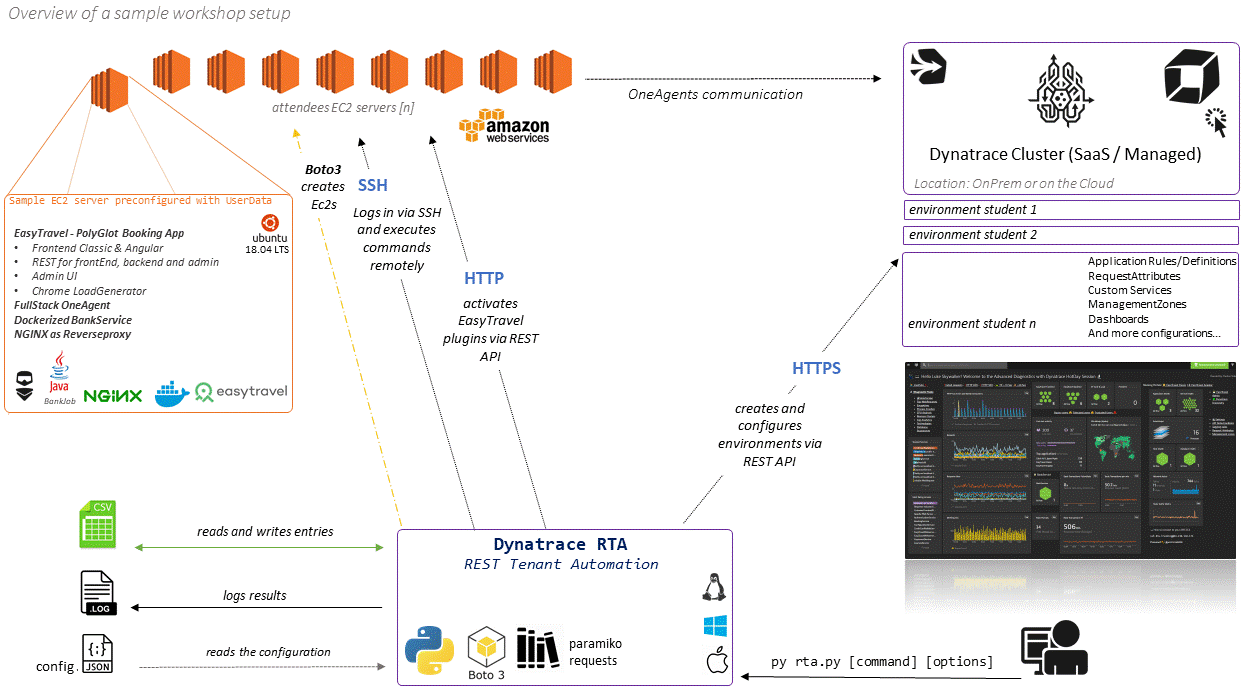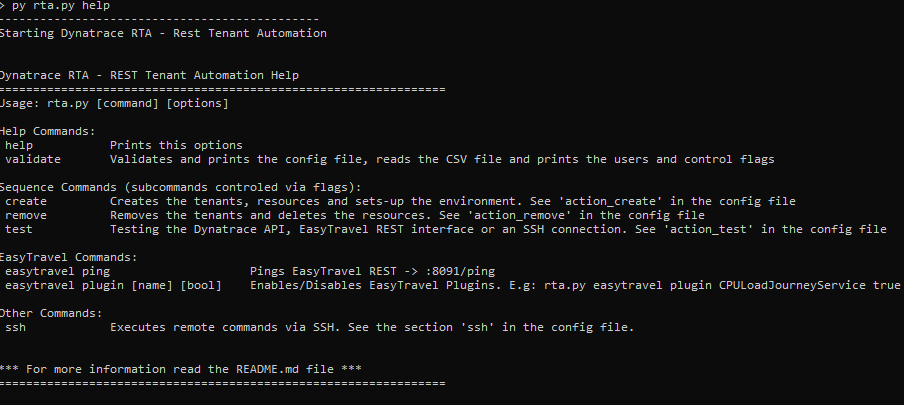DISCLAIMER: This project was developed for educational purpouses only and is not complete, nor supported. It's publishment is only intended for helping others automate environments for delivering workshops with Dynatrace.
Python program that creates and automates environments via the Dynatrace API. This small program reads a CSV file and will execute for each entry the command called (or a sequence of commands). Each entry in the CSV file can be controled via flags skiped=true as well as the subcommands. The subcommands of the actions create, remove and test can be controled via flags defined in the config.json file. This program can work with a Managed Cluster and SaaS environments.
The program will log the results and write it in the CSV when needed, like if it creates an EC2 instance it will write the instance-Id, the public DNS and IP.
This programm is very powerful for creating and automating environments for workshops. It will set-up an environment as defined with everything preconfigured such as custom dashboards linking them to the user-interface of the deployed applications of the created EC2 machines bein monitored by the OneAgent, ManagementZones, Request-Attributes, Application-Rules and it's definitions.
🦸♂️The Motivation and 💡 idea behind this, is that the 👨🎓 student gets everything configured so he spends more time learning Dynatrace and not configuring other things trivial to the Topic to learn.
-
AWS account
(optional for the ec2-actions) the program (boto3) will look into your
.awsfile for credentials. Here you can get a free account
- Create environments with user and user_groups (Managed)
- Configure Dynatrace environments
- Create customized Dashboards for single users
- Configure Applications and AppRules
- Auto Tagging rules
- Management Zones
- Request Attributes
- Custom Services
- Connect and execute commands via SSH
- Enable EasyTravel problem patterns via REST
- Read and write entries in a CSV file
- Write results in JSON format
- Write action results back in the CSV file
- results of the actions called
- tenantId
- ec2 instance id / publicIp / dns
- tenant token
- others...
- Logging
- Create an EC2 Instance with custom deployment 🔗 linked to each tenant
- OneAgent bound to the tenant
- EasyTravel (8080/8079), Admin Console (8094) and Angular (9080) configured
- Remove the EC2 Instance and deactivate and remove the tenant.
- Manage the execution with commands via Control RowFlags (true/false) for each row:
- skip - Skip the row for the actions
- isClusterAdmin - to add the User as a cluster admin
- Validate function to read the configuration and print the users in the CSV file. This commands will get you python, pip and the dependencies installed in your system.
sudo apt install python3
sudo apt install python3-pip
pip3 install -r requirements.txtAfter you have installed them, just run python3 rta.py help for printing out the help.
Before running any action is highly recommended that you run the validate function so you see the output of the configuration and the entries that will be executed in the CSV file.
python3 rta.py validate
The config.json file:
about the status of the action as well as the id of the tenant, usergroup tenant token, ec2 instanceId, ec2 public dns, etc..
The file allows also other custom rows and will not modify them. when rewriting.
====== [RTA] Rest Tenant Automation Configuration ======
cmc:
|-cmc_url : https://xxxxx.dynatrace-managed.com The url of the cluster (when using Managed) with no leading slash
|-cmc_token : XXXXYYYYYZZZZ The API Token of the Cluster. Needed for creating tenants.
csv_dir : csv The csv directory to read/write files.
csv_file : attendees.csv The file to read for the actions called.
log_dir : log The log dir
log_file : rta.log The log file
ssh:
|-ssh_dir : ssh The SSH dir
|-cmd_file : cmd.sh The shell file containing the commands to execute
aws:
|-aws_dir : aws The AWS directory
|-aws_config : instance.json The AWS configuration for creating EC2
action_test:
|-tenant_api : True Will validate the tenant API with the apiToken
|-ssh_connection : True Will validate the SSH connection
|-easytravel_ping : True Will ping the REST Services of EasyTravel
action_create:
|-create_tenant : True Will create the tenant on the Managed Cluster
|-create_user_group : True Will create the userGroup (managed)
|-create_user : True Will create the user (managed)
|-create_allinone_token: True Will create a paas and api token (managed/saas)
|-create_ec2_instance : True Will create an EC2 and install OneAgent
|-fetch_ec2_instance : True Fetches the DNS/public IP of the EC2
|-set_up_env : True Sets up the environment (See def set_up_environment(data))
action_remove:
|-deactivate_tenant : True Deactivates the tenant (managed)
|-remove_tenant : True Removes the tenant (managed)
|-delete_user_group : True Deletes the user group (managed)
|-delete_user : True Deletes the user
|-delete_ec2_instance : True Terminates the EC2 instanceThe enviroment creation applies only for Managed instances and consists of the actions create_tenant , create_user_group, create_user and create_allinonetoken. The tenant name is the firstName and the lastName of the attendee. The JSON definitions (templates) can be found in the skel directory.
In the function set_up_environment a tenant will be configured via the Dynatrace Environment API . A series of JSON definitions will be imported through different endpoints. The set-up of the environment is optimized for EasyTravel defining two applications, EasyTravel Classic (application-1.json) and EasyTravel Angular (application-2.json) and its application rules ate in the folder apprules. The other folders found inside the easytravel folder: autotagging, customservices, dashboards, managementzones, frequentissuesand requestattributes work with the dragndrop principle. All the JSON definitions found in each folder will be configured in the environment for the respective API endpoint..
The depicted dashboard below dashboard.json is customized for each environment. With a basic string replacement before posting the Dashboard on the API the attendees will get a highly customized Dashboard. The idea behind this is to deliver a good customer experience and optimize the flow of the class so that every resource that the user needs is placed in the dashboard such as:
- The credentials and information to log-in to their own EC2 instance
- Links to the applications deployed on the EC2 instance (EasyTravel Angular and Classic)
- Link to a live help plattform deployed in a masters server, where the users can collaborate, chat and get help.
- Agenda
- Links to the Repository
- Link to any other needed resource (inside and outside of the Dynatrace tenant)
for modifying the string replacement of the custom dashboard take a look at the
def environment_create_dashboards
You can easily control for which entry to execute the actions called. You can controll this with the column skip
skip = empty and false equals false. Meaning the actions defined in the program (command and config.json) will be applied to that user. If it contains True then the user will be skipped.
isClusterAdminGroup = empty and false equals false. True will set the user_group for the user to cluster_admin in the creation of the environment. This user will have access to the CMC and to all tenants. This only applies for Managed.
- The CSV is a semicolon ; separated file.
- The keys are case sensitive
- The order of the fields is not important
- The program will keep the order when rewriting the results of the actions created.
- The CSV may include as many other columns/key as necessary.
After calling an action, rows with the result of the action will be added to the CSV file. For redundancy (for example if the CSV is opened in Excel or another program and can't be written) inside the temp folder a copy of the CSV file with the results will be written. The files will have as name the timestamp and error as prefix if an error occurred.
| Key | Mandatory | default Value | Description |
|---|---|---|---|
| yes | the Email of the person | ||
| firstName | yes | the firstname of the person (part of the tenant name) | |
| lastName | yes | the lastname of the person (part of the tenant name) | |
| tenantId | no | will be generated | applies only for Managed |
| skip | no | FALSE | If found and if "true", the row will be skipped |
| isClusterAdminGroup | no | FALSE | If found and if "true", the userGroup will be added as an cluster admin. |
| tenantId | generated | the tenantId for Managed | |
| tenantUrl | yes | generated | for Managed it will be generated, for SaaS is mandatory with https protocol and no leading slash |
| tokenMmgt | generated | when creating an environment is the token for creation of API and PaaS tokens | |
| apiToken | yes | generated | for Managed it will be generated, for SaaS is mandatory when talking to the API. |
| paasToken | yes | generated | for Managed it will be generated, for SaaS is mandatory when creating an EC2 instance where the OneAgent (or ActiveGate) should be installed. |
| publicDnsName | no | when creating an EC2 instance this will be fetched. | |
| publicIpAddress | no | when creating an EC2 instance this will be fetched. | |
| sshUser | no | a DNS or IP address is needed. The user for trying to connect via SSH (port 22) and execute remote commands | |
| sshPassword | no | a DNS or IP address is needed. The password for trying to connect via SSH (port 22) and execute remote commands. Execute as sudo is also possible. |
The configuration of AWS is defined in a folder and in a JSON file specified in the config.json properties. In there you specify in which AWS region to create resources and the instance details for the creation.
The program uses boto3, which is a library for managing aws resources. This will work automatically if you have AWS cli set up in your environment so you don't have to code it or enter it everytime. Here is how to set up your environment credentials You can set them programatically, but I strongly advice to set them in your environment.
Be aware that the AMI instance IDs differ from one region to another, meaning an ubuntu has a different AMI ID for "Europe West" than "Europe East".
def customize_tags(tags, toReplace):By default AWS has a limit of 20 multiple instances running. You might want to check up that limit in the region if you want to instantiate more than 20 ec2's.
If you want to create multiple environments with their respective EC2's a the same time, I highly recommend to do it in two separate runs since the action fetch_ec2_instance and set_up_env depends on the creation of the create_ec2_instanceand waits until a public IP has been assigned to the instance. This can take a couple of seconds for each instance but waiting for 50+ may take multiple minutes. You can drastically reduce this if in the 1st run you execute the following actions:
"create_tenant": true,
"create_user_group": true,
"create_user": true,
"create_allinone_token": true,
"create_ec2_instance": true,and in the 2nd you execute the last two (fetch the public IP and set_up the environments). You can easily control this with the action control flags.
"fetch_ec2_instance": true,
"set_up_env": trueDo your changes/improvements and create a pull request. A tip for not forgetting pushing private configuration including tokens is marking those configuration files in your local repository not to be tracked. You can acomplish this by typing the following git command:
git update-index --assume-unchanged config.json

